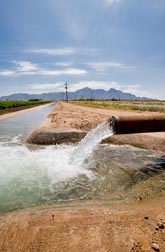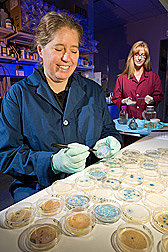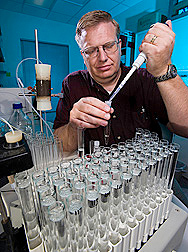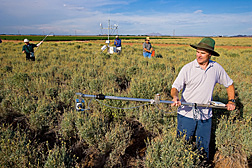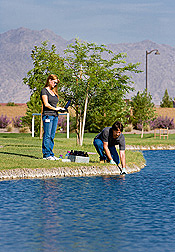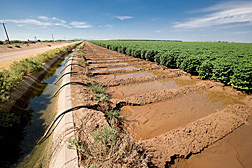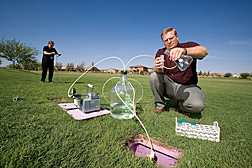Making Every Last Drop Count
Reusing Water in the Desert Southwest
Arizona’s burgeoning population is increasing pressure on the state’s limited water resources. Agricultural Research Service scientists at the U.S. Arid-Land Agricultural Research Center (ALARC) in Maricopa, Arizona, are investigating potential solutions.
Reclaim It, Reuse It
Microbiologist Jean McLain and soil chemist Clinton Williams are examining urban use of “reclaimed” water—which is drawn from residential and industrial sewage systems and treated to remove contaminants.
Since September 2006, McLain and Williams have collected soil and water samples from a municipal park that is being irrigated with reclaimed water and tested them for harmful shiga toxin-producing Escherichia coli bacteria. To date, the scientists have not found a single pathogenic strain of E. coli. They did note a small increase in soil salinity—a potential downside to using reclaimed water—but the level observed was too low to harm plant growth.
Williams has also tested for carbamazepine, an epilepsy drug that has been detected in low doses in drinking water. His research has shown that the drug is retained by organic matter found in soil. This suggests that any carbamazepine in reclaimed irrigation water is unlikely to leach beyond the root zone.
In two related studies, the researchers have addressed the accuracy of the tests used to confirm reclaimed water’s safety—an important step towards gaining the public’s approval.
In the first study, McLain and Williams found that the quality of reclaimed water is harder to assess in winter, when EPA-approved tests return considerably more false positives for E. coli. Over several months, they drew samples from a wetland fed with reclaimed water and placed each sample on a culture medium that changes color when E. coli colonies develop.
In December and January, they observed a surprising increase in positive tests. But genetic assays revealed that about 90 percent of these were false positives. So why were the media cultures—ordinarily dependable testing tools—delivering such inaccurate results?
Chemical analysis revealed that the water’s salt content increased in the winter months, suggesting that the false results may be related to salt chemistry, McLain says. The ALARC researchers are currently collaborating with scientists at the University of Arizona to confirm this hypothesis. This is important not just for the ARS team, but for all people who rely on the media for accurate assessments.
“Not every user has the high-tech assays to verify their media results,” McLain says.
Ensuring Accurate Tools
Working with researchers from Arizona State University (ASU) and the University of Arizona, McLain also monitored levels of fecal Bacteroides, a genus of anaerobic bacteria, in a pond fed with treated wastewater.
“Because they are prevalent in the feces of warm-blooded animals, Bacteroides are commonly found in the environment and in contaminated water,” McLain says. “But the pond levels were a little higher than we’d expected.”
Initial tests suggested that almost all the Bacteroides were of human origin, raising concerns about the efficacy of the wastewater-treatment process. The scientists ran control tests on feces from dogs, humans, birds, and tilapia, the fish species inhabiting the pond. When they analyzed the fish samples, they made a surprising discovery.
“The tilapia results were so similar to the human results that I first thought we’d contaminated the sample,” McLain says.
Instead, something more unusual was at play. Tilapia and humans carry different strains of Bacteroides, but genetic analysis revealed that the small segments of DNA used in the assays were not unique to human Bacteroides, but were exactly the same for both strains.
ARS and ASU are now collaborating to test other fish species to see if the similarities are widespread or specific to tilapia. They’re also developing a fish-specific source-tracking tool to confirm that their test results reflect the pond’s fish population.
“There are hundreds of fish in this pond, so at this point we can safely assume that they’re the cause of our high test results,” McLain says. “Once we develop the right tools, we can confirm that assumption scientifically.”
Improving Water Management
Meticulous water management is essential in arid environments, where water is a precious and limited commodity. ALARC scientist Bert Clemmens and his colleagues are exploring ways to improve two areas related to water management: canal automation and surface-irrigation modeling.
Large water-distribution systems gather water from rivers, reservoirs, or other suppliers and deliver it to agricultural areas via canals. In the United States, such systems may serve hundreds of thousands of acres.
“There are physical limitations to the service that can be provided to farmers by a canal system,” Clemmens says. “We’re working with individual districts to improve canal operations, and thus service to farmers, through automation.”
Clemmens and his colleagues have developed software logic that can control the position of canal gates. Sensors detect water-level changes within the canals and respond accordingly, moving the gates to increase or decrease the water flow. This would improve the efficiency and give land managers greater control and flexibility.
During a 30-day trial run in 2004, the ARS researchers set up automatic software to operate the gates on a small lateral canal in the Maricopa Stanfield Irrigation and Drainage District.
“The software successfully made 48 changes in water delivery and controlled water levels upstream from farm-delivery gates to keep flows to irrigators constant,” Clemmens says.
The scientists tested 19 different downstream water-level feedback controllers, enabling them to make recommendations for improved water control.
The researchers are currently applying the technology in the Central Arizona Irrigation and Drainage District—which covers about 87,000 acres of irrigated farmland—and developing training software for canal operators.
In related work, Clemmens and his colleagues have updated a software program called WinSRFR that simulates, designs, and evaluates surface-irrigation systems.
“Surface irrigation doesn’t have the best reputation for efficiency, but the majority of the world’s acreage is surface irrigated,” Clemmens says. “The WinSRFR model is a tool that can help maximize that efficiency.”
The USDA Natural Resources Conservation Service uses the program to evaluate proposed conservation practices and install more efficient surface-irrigation systems.
The model has modules that enable users to simulate the results of various management strategies. One module evaluates irrigation events. Another shows how different design options affect a field’s irrigation efficiency. A third shows the effects of various operational choices.
Though each module operates separately, information can be transferred between them. Together, they can help land managers make decisions about how to arrange and water their fields.
The model is available at www.ars.usda.gov/services/software/software.htm and has users throughout the United States and in 14 countries around the world.—By Laura McGinnis, Agricultural Research Service Information Staff.
| Arid Alternatives | |||
| One alternative for arid lands is to grow crops that require less water. For example, in Arizona, alfalfa is a major commercial crop that needs about 72 inches of water per acre per year. Instead, growing the crops listed below would offer significant water-conservation benefits. Exact water use varies from year to year, depending on weather, irrigation scheduling, and system efficiency. | |||
| Crop | Potential Commercial Uses | Growing Season |
Seasonal Water Use |
| Camelina | Biofuel and other biobased products | January to late May |
19-20
|
| Cotton | Clothing and medical supplies | April to October |
40-42
|
| Guayule | Latex alternative | Annual |
64
|
| Lesquerella | Cosmetics, plastics, and lubricants | October to early June |
24-25
|
| Wheat | Food | December to late May |
24-26
|
|
|
Research in the Public Eye
You can lead a horse to water, but you can’t make it drink—and its owners will be equally reluctant to irrigate with that water until they’re sure it’s cost effective and safe.
Education is an essential part of gaining the general public’s acceptance of new technology. How much will it cost? Is it safe and easy to use? What are the short- and long-term effects? These and other questions about reclaimed-water technology will be addressed at a new research-and-education location slated to open in Maricopa, Arizona, later this year.
The 1.5-acre site is the result of a collaborative effort between ARS and Global Water, a private water utility based in Phoenix, Arizona.
At the site, scientists will irrigate vegetation with either recycled or potable water and monitor the soil for chemical and biological changes. Stainless steel lysimeters—subterranean water-collecting instruments—will gather water samples 100 centimeters (about 39 inches) below the surface. Sensors within the lysimeters will collect information on soil moisture, temperature, and salinity.
“This work will reveal long-term environmental effects of irrigation with recycled water,” says microbiologist Jean McLain. “It will also provide the information water utilities need to develop guidelines and make informed decisions for safe recycling of water for irrigation.”
This research is part of Water Availability and Watershed Management, an ARS national program (#211) described on the World Wide Web at www.nps.ars.usda.gov.
To reach scientists mentioned in this article, contact Laura McGinnis, USDA-ARS Information Staff, 5601 Sunnyside Ave., Beltsville, MD 20705-5129; phone (301) 504-1654, fax (301) 504-1486.
"Reusing Water in the Desert Southwest" was published in the January 2009 issue of Agricultural Research magazine.







